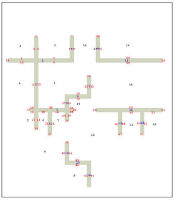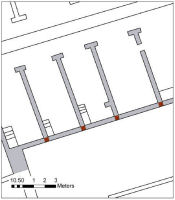
Figure 40: Standard nomenclature system for labelling walls, wall faces, and spaces (rooms).
The standard, and general, system for masonry analysis of previously excavated, or investigated, buildings is firstly to label the structural remains to be examined so that each component of these structures can be clearly identified in further discussion. Generally, one uses an existing plan of the site to label each wall with a number that is sequential to that of its neighbour. Next, each face of each wall is given a number that is sequential to its neighbour, and another number is provided for each of the spaces, such as a room, that these walls define (Figure 40). This system produces three independent sets of numbers to represent three interconnected aspects of the architecture and generally works well to direct on-site recording and masonry analysis (work-flow), but can cause several problems for subsequent analyses (data-flow). Additionally, this naming system does not serve all types of architecture equally well.

Figure 40: Standard nomenclature system for labelling walls, wall faces, and spaces (rooms).
A more specific system is that used by the Pompeii Forum Project (PFP) to explore the construction, chronology and social implications that accompanied the transformation of the Pompeian forum into the monumental heart of the city (Dobbins 1994; Dobbins et al. 1998; for information on the Pompeii Forum Project). To label these complex remains this project developed a condensed system in which the three sets of numbers from the standard system - wall, wall face, and space numbers - were merged into one number. The number for each wall and each wall face is derived from the related spaces by pairing the numbers of these spaces (Figure 41). For example, the west wall face of space '1' and the face on the other side of the same wall, the east wall face of space '2', are paired to label this wall 1.2. Moreover, this system can reflect which face of the wall is being discussed. By reversing the numbers, making wall 1.2 into wall 2.1, the perspective of the viewer is reflected, establishing that viewer as within space 2 rather than space 1. While the PFP system has advantages over the more traditional system, each of these naming conventions has built into them assumptions about the structure they label that lead to problems with its interpretation and to data incomparability in later analyses. For example, because the wall face is often the most observable part of the wall, it is treated here as if it were itself the primary or even the only object of study. This ignores the three-dimensionality of the wall during on-site recording, particularly its intersections with other walls (see Figure 43), and produces an image of the site's architecture as a hollow set of intersecting planes (Figure 42). Although the PFP system does away with the problem of multiple sets of similar numbers, it creates several problems of its own. The first is that this system risks presuming that the 'space' between the extant walls is a meaningful division of the architectural remains and not an accidental artefact of their preservation. Thus, while it is reasonable at Pompeii to equate a space with a room, at other sites, as at Isthmia for example, walls from different time periods can seem to enclose a space, yet were never intended to do so, nor did they ever function as a room. Even more difficult are the problems that each wall can equally be called by two different labels and, conversely, that the wall and wall face numbers are indistinguishable. For example, wall 1.2 (which has the same number as wall face 1.2) is also appropriately numbered wall 2.1, requiring that one face of a wall be designated as the primary wall number, causing a concordance of secondary wall numbers to be created, with each of these being identical to the opposite wall face number. This effect eliminates the value of the system's concision, and makes designing a database for the storage, reference, and analysis needlessly complex.


Figure 41: The Macellum at Pompeii (image is north-aligned; after Dobbins 1994, fig. 3).
Figure 42: Diagram indicating wire frame of hollow walls.
The problem is compounded when one needs to refer to a long wall intersected by multiple cross walls. Consider, for example the north-west quadrant of the Macellum at Pompeii (Figure 41). While the segment of the cross wall between spaces 3 and 4 is called either wall 3.4 or 4.3, the length of the wall that it intersects is called wall 3.28, 4.28, 5.28, 6.28, 7.28 or, alternately, 28.3, 28.4, 28.5, 28.6, 28.7. The nomenclature for such long walls quickly becomes cumbersome and referring to them as entities is increasingly difficult as more sections are included. Moreover, it is unclear how, or even if, the cube of material filling the intersection of the wall face planes is labelled and recorded (Figure 43).

Figure 43: Examples of the unrepresented cubes of masonry (red) that usually join wall segments.
The standard system of using sequential sets of numbers for walls, wall faces, and spaces, respectively, has the opposite problem with long walls. Instead, it suffers from the presumption that the same long wall intersected by multiple cross walls is in fact a singular and indivisible construction. Field work can easily prove such a presumption false. To incorporate the observation, for example, of one wall being comprised of stratigraphically two distinct walls, the original long wall must be subdivided, requiring a redrawing of these walls' shapes and the creation of a new sequential wall number to reflect the new wall. More importantly, this revised numbering system will require the careful review of all previous records referring to the original wall to ensure that they are in fact referring to the corrected wall number. As the first step in most masonry analysis, therefore, the system of nomenclature, and in particular these two systems, potentially inhibit field recording, data comparability and off-site analysis.
© Internet Archaeology/Author(s)
URL: http://intarch.ac.uk/journal/issue24/3/appendix_a.html
Last updated: Mon Jun 30 2008